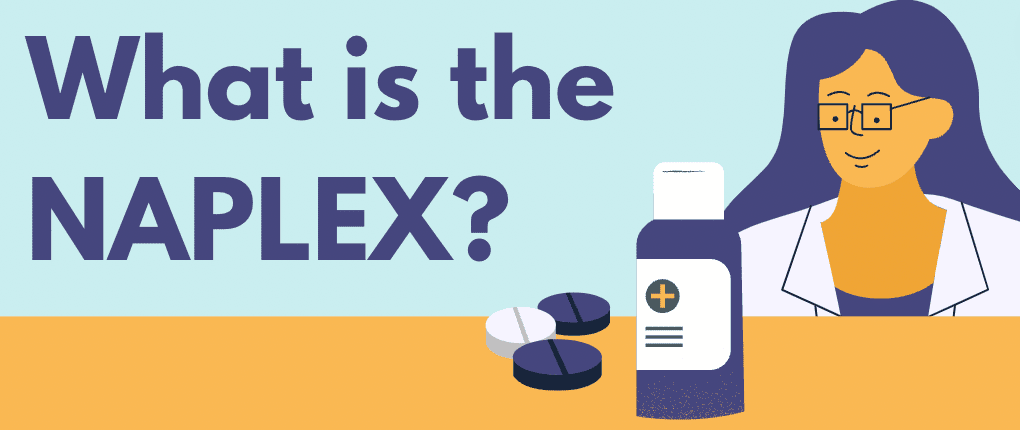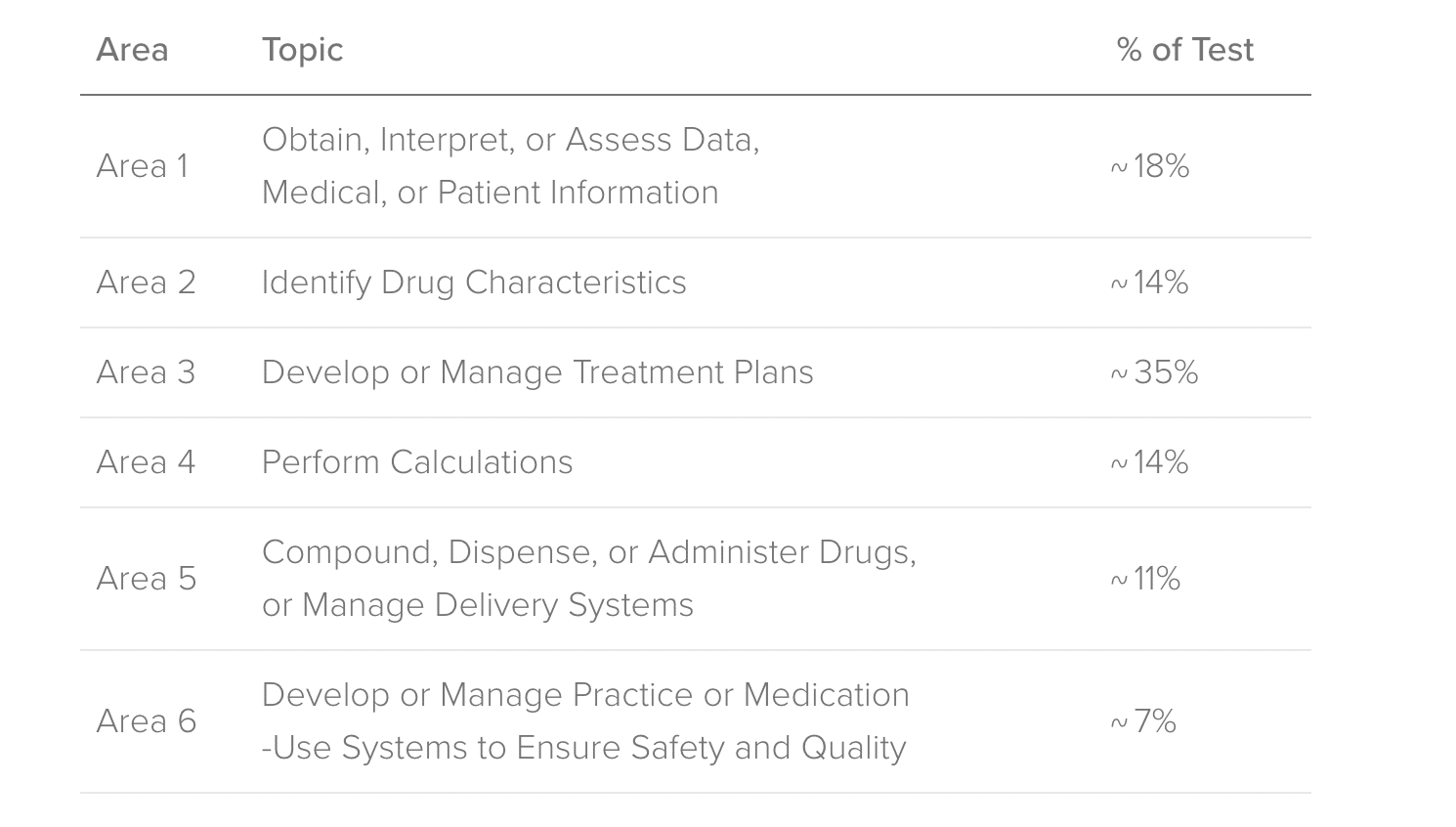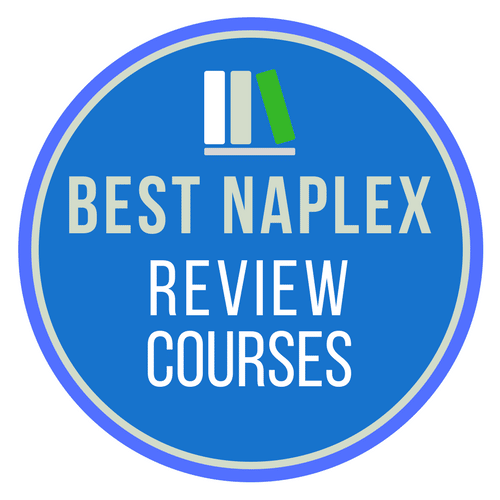

What is the NAPLEX?
The NAPLEX® is a computerized test consisting of 250 questions with multiple-choice answers. Its purpose is to identify whether or not applicants have the knowledge, judgment, and skill necessary to practice pharmacy at an entry-level competency level. The exam evaluates candidates’ knowledge and skills in three essential areas: the management of drug therapy; the preparation and administration of pharmaceuticals in a safe and correct manner; and the provision of drug information and the promotion of public health. Visit the NABP website for a comprehensive rundown of the NAPLEX competency categories and statements.
Many of the questions on the NAPLEX test are what are known as “scenario” questions, and they pertain to specific patient profiles. To answer these questions, you need to have a strong foundational understanding of pharmacy as well as the ability to evaluate information about patients. The vast majority of the remaining questions are run-of-the-mill multiple-choice items of the “stand-alone” variety, in which a question is posed followed by a list of possible responses but no patient profiles are provided.
The NAPLEX utilizes a rule known as the “one-best-answer rule,” which states that even if several response options could make sense, there is only one answer choice that is optimal. You should be prepared to respond to questions that require a single answer as well as those that require several responses. When answering questions with a single correct response choice, you are required to select the solution that provides the most accurate completion of a statement or answer to a question. When answering questions that need a combined response, you will be given a number of different answer component combinations from which to pick.
What Should You Expect Taking The NAPLEX?
You will have around six hours to answer all 250 questions presented to you via a computer. There are two planned breaks, each lasting ten minutes and being completely voluntary. There are fifty practice questions on the examination, and the student’s performance on these questions does not go into their final grade. However, there is no way to tell which questions will be on the pretest, so students need to answer each question as though it counts.
The NAPLEX is no longer adaptive, which means that all of the questions have to be answered in the sequence that they are presented. Once they have provided an answer to a question, test takers are unable to return to that question.
How is the NAPLEX Scored?
Your score on the NAPLEX® is a scaled score, which means that your final score is neither a score based on the number of questions answered correctly nor a score based on the percentage of questions answered correctly. Instead, your final score is an independent value that is determined by factors such as the number of questions you answered correctly and the level of difficulty of the questions you were asked. Any scaled score of 75 or higher is regarded to have met the requirements for passing.
You are no longer need to answer a predetermined minimum number of questions in order to obtain a score. Questions to which no response was given received a score of zero. You are obligated to provide responses to all of the questions, even if you have to make educated guesses.
What are the pass rates for the NAPLEX?

On its website, NABP provides users with access to the organization’s annual pass rates for the NAPLEX. The following is a list of the overall pass rates for graduates who received their degrees from programs that received accreditation from the Accreditation Council for Pharmacy Education® (ACPE®) between the years of 2019 and 2021.

What kind of questions are asked on the NAPLEX, and how are they broken up?
The NAPLEX Competency Statements provide an overview of the broad practice topics that will be assessed across all 225 questions in the test. They contain vital information regarding the knowledge, judgment, and abilities that are anticipated to be demonstrated by an entry-level pharmacist. It would be helpful for you to prepare if you have a firm grasp of the competence statements and their distribution on the test. The table that follows provides a summary of the six areas of competency that will be examined as well as an estimate of the percentage of questions that will be asked in each of those categories.
How to verify your results after taking the NAPLEX
By submitting an application for the NAPLEX, you are giving the NABP permission to release the results of your test to the pharmacy board in your state. NABP will submit your test results to the board from which you are seeking licensure, as well as any jurisdiction to which you have requested a transfer of your NAPLEX score, unless NABP has withheld or invalidated your exam results. In this case, NABP will not forward your exam results.
The majority of states will upload NAPLEX results to the candidate’s NABP e-Profile once the exam has been taken. Candidates can obtain access to their results by entering onto their profiles and selecting the “Exam Services” and “Exam Results” pages, respectively, once they have been assigned a unique login and password. Clicking “View Report” under the “Test Results” tab on a candidate’s e-Profile gives them access to their Candidate Performance Report, even if they received a result indicating that they did not pass the exam. This report will include supplementary data and information regarding the performance of the candidate.
Candidates who took the licensing exam in Guam, Illinois, Minnesota, Montana, Puerto Rico, Wisconsin, and the Virgin Islands will get their results directly from the board of pharmacy or regulatory body of that state or territory. This is the case in California, as well (typically by mail).
How long does it take to receive your results after taking the NAPLEX?
After taking their examination, the majority of applicants will receive their NAPLEX results around seven business days later. The majority of states have made it possible for you to view your exam results within your NABP e-Profile. It is possible that candidates from states who do not take part in the NABP’s online test results portal would have a different amount of time to wait.
What happens if you fail the NAPLEX?
Candidates who obtain a result of “fail” on the NAPLEX are able to access their Candidate Performance Report on their e-Profile in order to view additional information regarding their performance on the exam. The purpose of this report was to provide test-takers with a breakdown of their accomplishment levels in each competence area in order to better help them. Candidates can make use of the report to enhance their level of preparation for future NAPLEX examinations, and so increase their likelihood of passing such examinations.
What are the topics on the NAPLEX?
The candidate’s performance in each of the six areas of competency tested by NAPLEX is evaluated and commented on in this report.

The following characteristics are used to categorize each aspect of an individual’s performance:
- Poorly falling short of the required minimum performance
- Does not achieve the required level of performance
- Obtains the required level of performance
- Surpasses the required level of performance
How Many Times Can You Take the NAPLEX?
Individuals who receive a failing score on the NAPLEX may repeat the test up to five times, provided that they meet the qualifying requirements established by their respective state boards of pharmacy. That is to say, certain states may permit fewer tries, but none of them permit more than five. Candidates are permitted a maximum of three tries per one year, at which point they will be required to reapply and pay the applicable application costs once more.
The state board of pharmacy to which the applicant is applying is the one that is responsible for determining whether or not the candidate is eligible. In order to reapply, the candidate has to wait the obligatory waiting time that NABP has established, which is 45 days. If an applicant is unsuccessful during all three of their tries, they will be compelled to wait at least one year from the time of their first attempt before making another attempt.
Can a NAPLEX score be transferred?
The NAPLEX score transfer service enables candidates who seek to receive a pharmacy license in various jurisdictions to quickly transfer their scores to numerous boards of pharmacy in those states. Candidates have the option of purchasing NAPLEX score transfers either at the time they purchase the test or at any time up to 89 days after they have completed the exam. Each score transfer request costs $75.
No of whether or not you pass the NAPLEX exam, your score transfer requests will be completed. If you take the test more than once and want to transfer your score more than once, you will need to pay for a fresh transfer request each time.
How long is the validity period for transferring a score?
The length of time that a score may be transferred validly from one site to another varies from place to place. Transferring of NAPLEX scores is permitted in all 50 states, as well as the District of Columbia, Guam, Puerto Rico, and the Virgin Islands. However, in order to obtain further information, it is recommended to get in touch with the boards of pharmacy in each particular state (e.g., current board fees, updated participation information).
How To Register For The NAPLEX?

The process of registering to take the NAPLEX® and scheduling a date for the exam consists of many steps.
Your first step should be to make contact with the pharmacy board in the state in which you wish to get licensed. Documentation and instructions will be distributed by the state board. Your eligibility to take the exam will be determined by the state board, which will then inform the NABP. After that, you will be given an Authorization to Test that contains the details listed in the following:
- test authorization number
- expiration date
- range of dates during which you can take the NAPLEX
The next step is to make an appointment for your assessment with Sylvan Prometric. In order to set a date for your exam, you will need the information from your Authorization to Test.
NAPLEX Strategy Sessions
There is no doubt that being familiar with the content is the most effective tactic for passing the NAPLEX® exam. If you lack topic understanding, your odds of passing the NAPLEX, let alone performing well on the exam, are extremely low to nonexistent. Having a strong familiarity with the material does not, however, ensure a good result. You must also demonstrate an ability to APPLY the knowledge in a manner that corresponds to the NAPLEX Competency Areas. You also need to ensure that you can respond to the questions within the specified amount of time. On a standardized test, there is nothing more irritating than discovering that you have run out of time.
In addition, you’re going to need to maintain your calm if you want to do well on the NAPLEX. There will be a good number of queries to which you will not have a response. People that are good at taking tests won’t freak out! They will first make educated guesses, then proceed to carefully remove the potential distractions they are aware are incorrect.
We highly suggest obtaining a top notch NAPLEX course and associated study materials to ensure you pass. You can see the best NAPLEX review courses here.
Example NAPLEX Study Plan
The Week Before the NAPLEX
This is not the time to try to pack in new information; rather, you should focus on organizing and integrating the information that you currently have. Make an effort to ensure that what you know is easily accessible.
Conduct a review of the relevant keywords, phrases, and concepts. One more time, read over the notes you’ve compiled in summary form. Right now is the moment to quiz yourself on the most important knowledge. The most important thing is not to just read through the content again but rather to practice recalling information. Probably all you need to know is already stored in your brain. At this point, it is up to you to train yourself to access it whenever you might require it. You may improve your ability to retain information by challenging yourself with practice questions. Just keep in mind that the questions you get on the practice tests are typically easier than the ones you get on the actual test. Don’t freak out if you can’t get them correctly the first time. Make use of them so that you may better comprehend the important aspects.
Be truthful with yourself about the things you know and the things you don’t know. When you go into an exam with the awareness that you do not know something, you have a greater feeling of control over the situation. You are also less likely to experience a panic attack when you are presented with the subject or to waste time on questions that you are not likely to get right. If you get to a question and realize that you do not know the answer, just circle the option that you think is best and go on to the next question.
Put yourself on the proper track with regard to your time plan. You should get out of bed every morning at the same time that you will have to on the day of the test. Your natural 24-hour rhythm will eventually adjust to the new schedule as a result of this. Do not snooze between 8:00am and 5:00pm. In such case, you run the risk of training your body to shut down during the most important parts of the exam. If you train yourself to get up at the same time every day, it will be much simpler for you to doze off when the time comes. If you get into the habit of maintaining a regular sleep-wake cycle, it will be much simpler for you to fall asleep on the night before the test.
You need to ensure that you are receiving enough sleep each night. That equates to a minimum of six to seven hours of sleep for the majority of individuals each night. During sleep, your brain is able to process new information and make connections between previously acquired knowledge. You may become a more effective student when you are awake by getting enough sleep each night.
Make sure you give yourself some downtime every day. I hope you like your lunch. Take a stroll outside and enjoy the clean air. Find time in your schedule to exercise. You will feel revitalized as a result of the change in routine, and the physical exercise will assist you in unwinding and falling asleep at night.

You should go to the Sylvan Center, which is where the test is going to be given, if you haven’t already done so. It will be written on the admittance ticket that you use to enter the exam. This will guarantee that you are aware of how to get there as well as the appropriate amount of time to set aside for the journey. You are able to view both the location of the parking spot and the configuration of the computer system.
Review the NAPLEX® Candidate’s Review Guide, which is available for download from the NABP. If you have not done so already, please do so now. Get yourself acquainted with the user interface, learning where important information is located on the screen as well as how to move between displays. On the day of the test, you will feel significantly more at ease if you enter the testing environment already familiar with the test.
Day Before The Exam
Stop studying for the day and go do something else. Before tomorrow’s big event, today is a day off for you, so take some time to unwind and recharge your batteries. Get out of bed at the same time that you will be required to get out of bed the following day. If you have the feeling that you need to study, just focus on going over your own notes and flashcards.
Have some fun. Proceed to take a stroll. Play some of the music that you enjoy the most. See a movie that will allow you to have a cathartic release, such a good comedy or an action flick. Go shopping. Spend time with a person who is important to you. You can act anyway you choose. You have put in a lot of effort, and this reward is well-earned.
Make sure that you have familiarized yourself with the fundamentals of the test: have you gone through the lesson that is included in the NAPLEX® Candidates Review Guide? Do you have a general idea of the location of the Sylvan center and how to get there?
Have a contingency plan ready: Have you made arrangements for other modes of transportation in the event that, for instance, your car would not start? Do you have faith that your alarm clock will awaken you at the appropriate time? In that case, you should make other plans with your buddies. You need to ensure that you get enough sleep, that you feel refreshed, and that you get up on time.
Before you go to night, organize everything you’ll need for the test the next day. This contains any personal goods such as eyeglasses, as well as picture identity, a scheduling permission, and a confirmation number.
Make some preparations to celebrate when the test is complete by calling some of your friends and classmates and getting the party started. You are going to need to blow off some steam anyhow, and conversing with your coworkers will serve as a helpful reminder that you are not in this fight alone.
Make sure you get some sort of exercise every day. A simple activity like going for a stroll for an hour will help you unwind.
Get a good night’s sleep. Think about taking a warm bath or drinking some warm milk before bed to help you fall asleep. You should try to avoid using sleep medicine because it might cause you to feel foggy in the morning.
Exam Day
The day you take the NAPLEX® is NOT going to be the most significant day of your career; rather, it is only another obstacle in the path to becoming a licensed pharmacist. Maintain your sense of perspective. Consider the test to be no more than a normal piece of machinery to be operated on. Take care of each question when you get to it, make your decision, and then go to the next step.
You will not pass the NAPLEX without making some mistakes, regardless of how well prepared you are for the exam. Prepare yourself to feel like a fool. You should not go into this test assuming that you already know the answers to all of the questions. In light of this information, your approach to taking the test need to be rather distinct from the strategies you use when you take previous examinations.
Arrive at the Sylvan Center thirty minutes early in order to avoid feeling rushed and to give yourself sufficient time to prepare. After that, a computer station will be allotted to you, and you will be provided a locker to store your personal belongings in. Keep in mind that you have a total of 4 and a quarter hours to answer 185 questions, and that you are required to take a break for 10 minutes after about 2 hours has passed.
You are going to need to maximize your break time in order to combat the effects of exhaustion. Take care of your requirements in the same order as their relative significance to your level of comfort. It is highly recommended that you go to the toilet, grab a brief drink, and stretch your legs before continuing.
When modifying your responses, use extreme caution. In most cases, the probability of turning a correct answer into an incorrect one is so much higher than the probability of changing an incorrect answer into a correct one that it is just not worth taking the risk. If you decide to alter an answer, there is a good chance that you will get it wrong! Almost always, you should go with your initial inclination. Continue on with it until you get an epiphany or some other clear revelation.
Keep an eye on the clock to determine how much time you have left and to avoid feeling pressured at the end of the task by preventing yourself from running out of time. You should start working on your pace as soon as the exam begins. Every 10 questions, check your watch or the on-screen timer to ensure that you are keeping up with the appropriate speed to complete the test. If you maintain a steady pace throughout the test, you shouldn’t find yourself rushed for time at the conclusion of it.
During the break, make an effort to unwind and get your mind off of the test that just took place. The want to think back on questions is powerful, but it will not be beneficial. Those inquiries are now in the past; you won’t have to worry about them ever again. You should make it a priority to unwind and make the most of your break. Remember that you have a natural tendency to remember the questions that you answer incorrectly.

